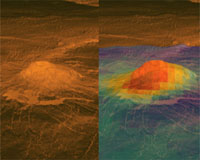 |
Paris, France (ESA) Apr 22, 2010 Venus Express has completed an 'aerodrag' campaign that used its solar wings as sails to catch faint wisps of the planet's atmosphere. The test used the orbiter as an exquisitely accurate sensor to measure atmospheric density barely 180 km above the hot planet. During five aerodrag measurements last week, Venus Express' solar arrays and control systems were operated as one big flying sensor, with the solar arrays rotated at various angles to the direction of flight. The special configuration exposed the wings to the vanishingly faint wisps of atmosphere that reach to the boundary of space around Venus, generating a tiny but measurable aerodynamic torque, or rotation, on the satellite. This torque can be measured very accurately based on the amount of correction that must be applied by reaction wheels, which counter-rotate inside the spacecraft to maintain its orientation in space.
Mimicking the vanes of a windmill On the last day, 16 April, the solar arrays were rotated at plus and minus 45 degrees to the atmospheric flow, mimicking the vanes of a windmill, in order to gather additional information on the behaviour of the molecules of the atmosphere bouncing off the solar wings.
A very capable satellite Camino explained that the mission operations team will study last week's results to develop an optimised configuration for aerodrag campaigns in October and in 2011. Aerodrag testing was also conducted in 2008, 2009 and February 2010. Continued positive results may enable Venus Express to conduct more sophisticated investigations deeper in the atmosphere, which would be of immense interest to planetary scientists. The solar array on Venus Express comprise two symmetrical wings supporting gallium-arsenide solar cells. Their combined 5.7 sq m can generate up to 1400 W of power in Venus orbit.
Share This Article With Planet Earth
Related Links Venus Express Venus Express News and Venusian Science
 Venus Express Images Reveal A Geologically Active Venus
Venus Express Images Reveal A Geologically Active VenusPasadena CA (SPX) Apr 12, 2010 For the first time, scientists have detected clear signs of recent lava flows on the surface of Venus. The observations reveal that volcanoes on Venus appeared to erupt between a few hundred years to 2.5 million years ago. This suggests the planet may still be geologically active, making Venus one of the few worlds in our solar system that has been volcanically active within the last 3 million y ... read more |
|
| The content herein, unless otherwise known to be public domain, are Copyright 1995-2010 - SpaceDaily. AFP and UPI Wire Stories are copyright Agence France-Presse and United Press International. ESA Portal Reports are copyright European Space Agency. All NASA sourced material is public domain. Additional copyrights may apply in whole or part to other bona fide parties. Advertising does not imply endorsement,agreement or approval of any opinions, statements or information provided by SpaceDaily on any Web page published or hosted by SpaceDaily. Privacy Statement |